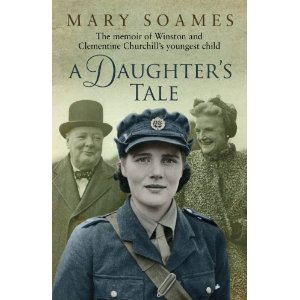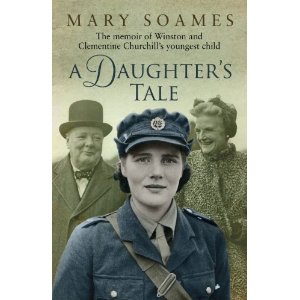
Bulletin #41 - Nov 2011
Winston Churchill’s Daughter, Lady Soames, Publishes Her Long-Awaited Memoirs: A Review by John Plumpton

November 15, 2011
Thriving in the Shade a Great Oak
By John Plumpton
A Daughter’s Tale: The Memoir of Winston and Clementine Churchill’s Youngest Child, by Mary Soames. Doubleday, hardbound, illus. 416 pages, £25, Amazon UK £15.59. To be published by Random House, USA in May 2012, 352 pages, $28, Kindle edition $13.99.
Mr. Plumpton is a former president of The Churchill Centre and has contributed to Finest Hour for thirty years. An enthusiastic sailor, he named his first boat Enchantress, after Churchill’s pre-World War I Admiralty yacht.

2024 International Churchill Conference
It may be apocryphal, but Randolph Churchill is said to regretted the difficulty of acorns surviving in the shade of a great oak. That’s true sometimes, but not always. In some cases, acorns thrive, and fall not far from the parent. One such example is Mary Churchill, now The Lady Soames, Patron of The Churchill Centre, whose personal story is wonderfully told in her long-awaited autobiography—and what a tale it is.

Author of five previous books on her family, Lady Soames recounts the rapid-fire events of her first twenty-five years, culminating in her marriage to Christopher Soames in 1947. She was born at the same time as her father made an offer to purchase Chartwell Manor, a house she has treasured all of her life. This book brings Chartwell alive as a home better than any guidebook.
She opens with a poignant account of the sad death in 1921 of Marigold Churchill, the beloved “Duckadilly.” A year later Mary arrived: “Perhaps I was, for my parents, the child of consolation.” We meet Maryott White (“Cousin Moppet” or “Nana”), Clementine’s cousin and Mary’s godmother, nanny/governess and lifelong friend. With her parents often in London and abroad, “Nana in all matters ruled my existence—always loving and always there.”
Prior to going to school, Nana introduced the precocious young child to the joys of the literature: a passion that has remained throughout her life. Reading aloud by Nana began at tea-time and continued through an extended (intentionally) preparation for bed. Lady Soames recalls being enthralled the Beatrix Potter books, Black Beauty, Alice in Wonderland, Peter Pan, Treasure Island, Uncle Tom’s Cabin: a cornucopia of children’s classics. She was one of the first to be spellbound by her father’s renderings of Macaulay’s Lays of Ancient Rome. A still treasured possession is a gift from her sister Sarah, “a lovely green leather-bound copy of The Oxford Book of English Verse, much faded now”). Her love of literature expanded to the theatre, and there is a litany of the great plays of the 1930s and 1940s that she enjoyed with friends and family.
Mary Churchill grew up in an adult world in a large, extended family, and her remembrances are full of insight: “I loved my parents unquestionably and my mother I held in considerable awe. I thought her very beautiful, sought to please her, and greatly feared her displeasure…My relationship with my father was altogether much easier—it just seemed to happen. Of course, he did not have to deal with the small print of my life or wrestle with my shortcomings in the same way as my mother.”
Her siblings were all very different: “Randolph was too distant from me in age to be part of my scheme of things…I was always rather alarmed by Randolph. Diana was benevolent towards me but was chiefly London-based, coming down to Chartwell on weekends. Sarah was my childhood heroine and my greatest friend.”
Winston’s large circle of intimates and associates are recalled here, including Professor Lindemann, Eddie Marsh, Duff Cooper, Bernard Baruch, Lawrence of Arabia (“I liked him very much and noticed his piercing blue eyes and intense manner”), and Lloyd George (“I was strongly and immediately struck by the great man’s white locks, his animation and his celebrated Celtic charm”).
The Second World War was a formative influence on Mary Churchill, and takes up half of the book. She began the war living at Chequers, an 18-year-old volunteer with the Women’s Volunteer Services. Upon learning of the formation of the Auxiliary Territorial Service (ATS) with the Royal Artillery, she and her cousin and friend Judy Montagu joined up to become “gunner girls.” She traces her career from training centres throughout England until she assumed command of an anti-aircraft battery in Hyde Park, and later in southern England. She also served as aide-de-camp to her father on his important overseas journeys to the Quebec Conference in 1944 and the Potsdam Conference in 1945.
Young Mary lived an eclectic wartime life, enduring the privations of ordinary soldiers, while staying betimes with her parents at Chequers and No. 10 Annexe, the above-ground rooms where her father spent most of his time in London. She had an active social life. Like most of her peers, she enjoyed being “footloose and fancy-free and very much on the look-out for romance.” She declined two marriage proposals—actually three because the eventual winner, Christopher Soames, had to propose twice before she accepted.
Her military life was not that of the average “gunner.” Her father would sometimes invite important guests to join him in watching Mary’s unit in action while under attack. Despite these intrusions, it pleased her that neither her commanding officers nor her peers resented their presence or treated her other than as a colleague.
One of the most interesting parts of her story are her fascinating portraits of the VIPs she met during the war: Harry Hopkins (“at first a somewhat dour impression but which soon emerged great personal charm”); Jan Smuts (“calm demeanour and wise judgment”); Charles de Gaulle (“a stern, direct giant. We all thought him very fine”); Mackenzie King (“very nice but a bit of a maiden aunt [and] a cosy old thing”); Franklin Roosevelt (“most kind, charming and entertaining”).
There are glimpses of most of the Allied military brass, but the two that stood out for Mary were Lord Louis Mountbatten (“good-looking and most affable. Sarah and I fell for him in a big way. I remember we somewhat disrespectfully dubbed him Glamour Pants”); and Sir Harold Alexander. In 1945 she wrote to her mother: “The person I’ve really lost my heart to is Alex—who is definitely my fav’rite Field Marshal. He is one of the few people I fell for at the age of 17 who has stood the stern test of time.”
Even at a young age, Lady Soames had an eye for detail and character analysis, and a winning way of describing it. There are moving descriptions of the loss of family and friends during the war, and accounts of “tensions and difficulties on the family front,” even as great global events were unfolding. We are reminded throughout the book that the Churchills were not only a great family—they were also a very human family in ways that historians are unable to capture.
Although there is a bibliography, the major source is the diary the author has kept for most of her life. Assuredly it is one of the great documents of history, that some day may be a major resource for historians. In the meantime, A Daughter’s Tale is a most illuminating portrait of the early life of a remarkable woman who was truly a worthy offspring of Winston and Clementine Churchill.
Subscribe
WANT MORE?
Get the Churchill Bulletin delivered to your inbox once a month.




